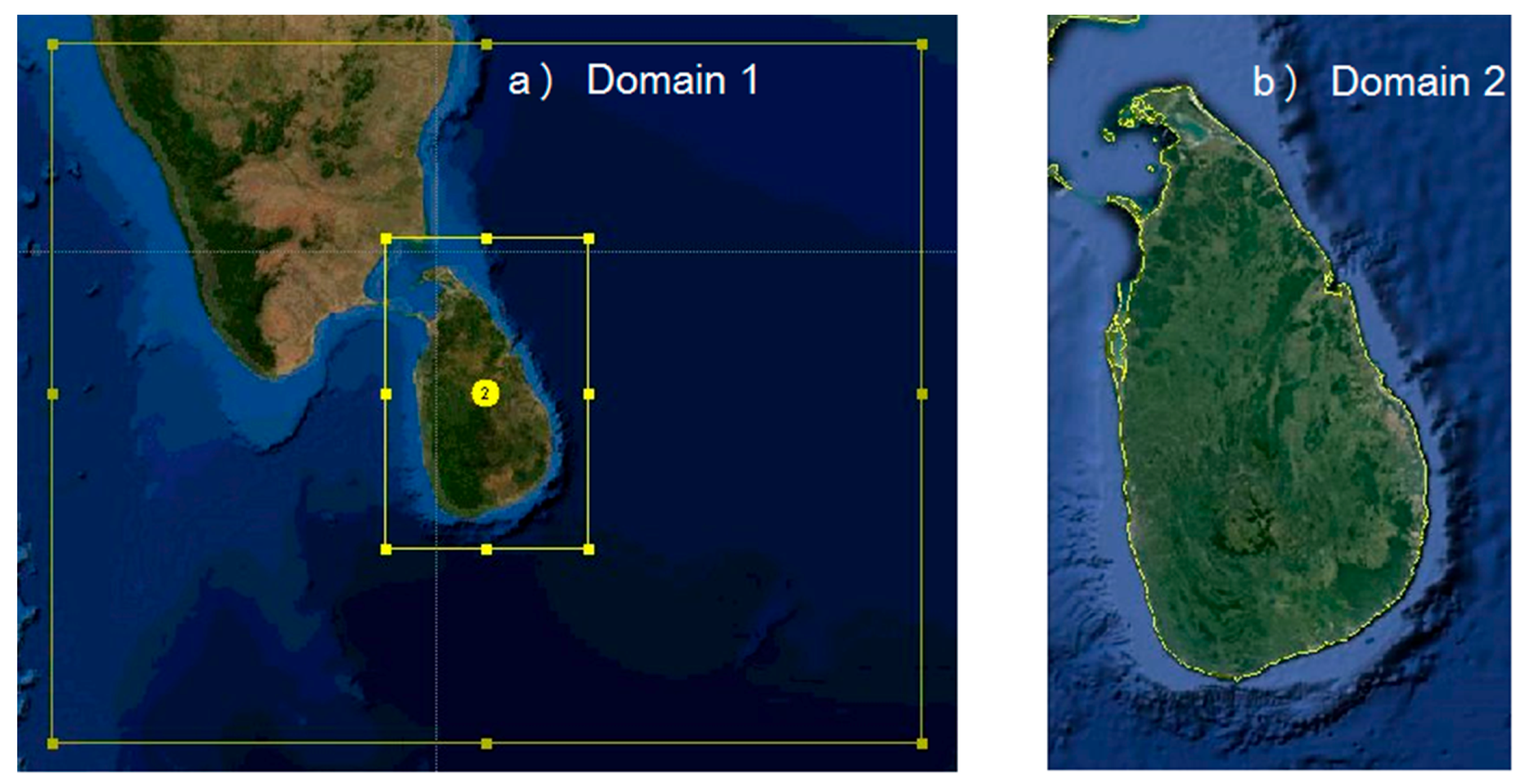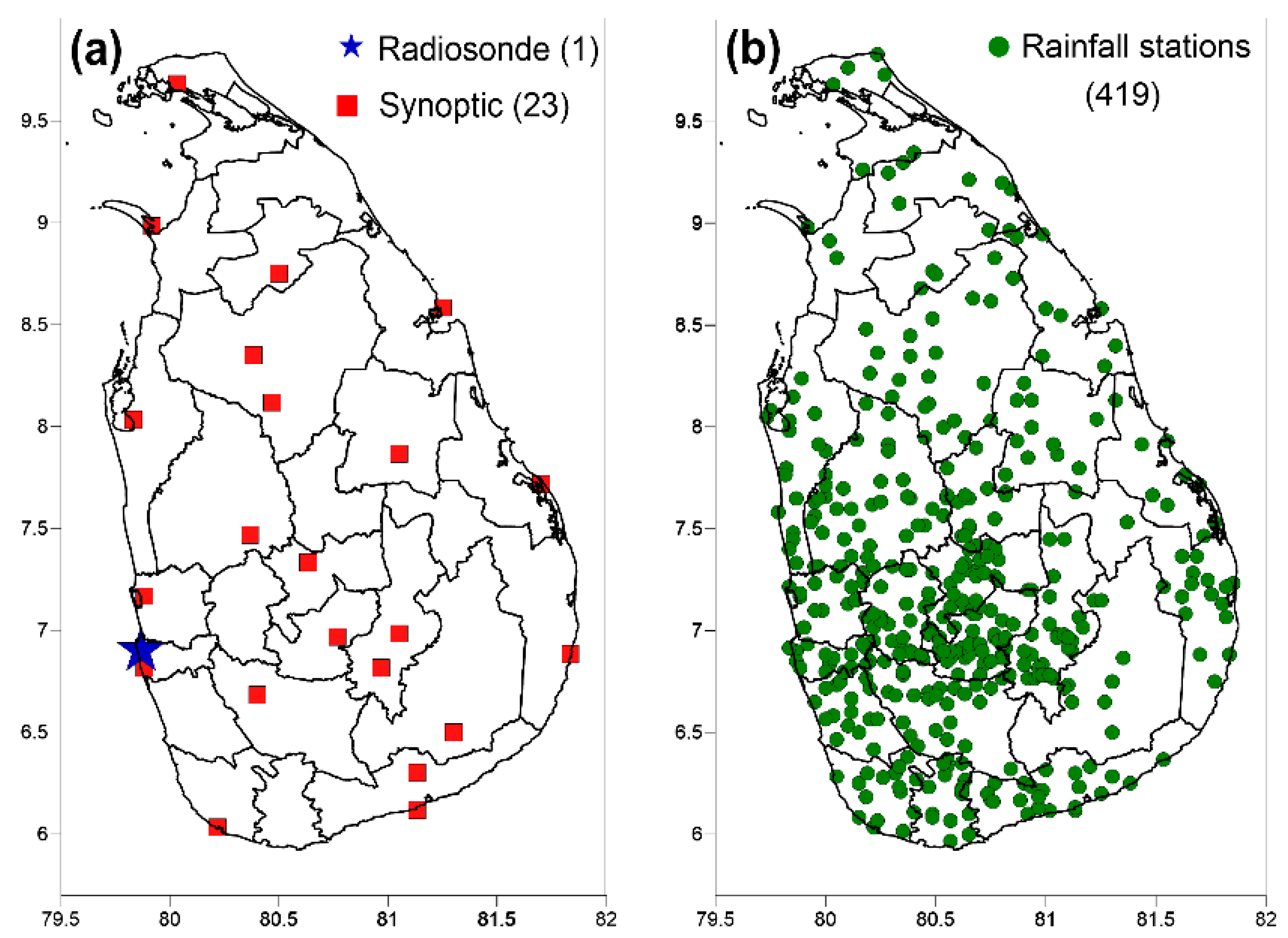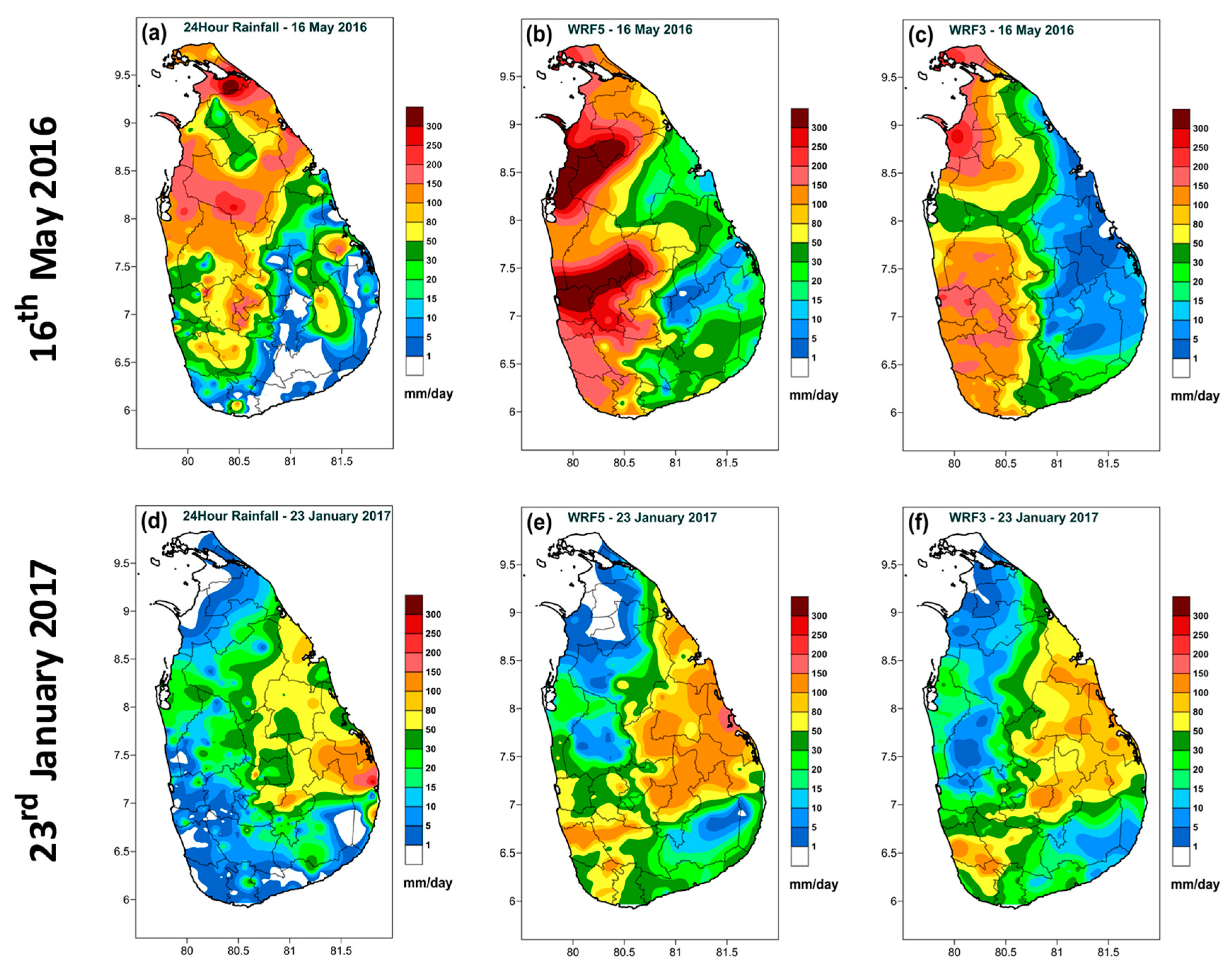Sensitivity Study of WRF Numerical Modeling for Forecasting Heavy Rainfall in Sri Lanka
Abstract
:1. Introduction
2. Method
2.1. Study Area and Events
2.2. Method and Materials
2.2.1. Basic Model Configuration
2.2.2. Experimental Set-up
2.3. Data
2.4. Statistical Skill Scores
3. Results and Discussion
3.1. Model Horizontal Resolution
3.2. Impact of Physical Parameterization
4. Summaries and Remarks
Author Contributions
Funding
Acknowledgments
Conflicts of Interest
References
- Hapuarachchi, H.A.S.U.; Jayawardena, I.M.S.P. Modulation of seasonal rainfall in Sri Lanka by ENSO extremes. Sri Lanka J. Meteorol. 2015, 1, 3–11. [Google Scholar]
- Rasmusson, E.M.; Carpenter, T.H. The relationship between eastern equatorial Pacific sea surface temperatures and rainfall over India and Sri Lanka. Mon. Weather Rev. 1983, 111, 517–528. [Google Scholar] [CrossRef]
- Zubair, L.; Ropelewski, C.F. The strengthening relationship between ENSO and Northeast Monsoon rainfall over Sri Lanka and Southern India. J. Clim. 2006, 19, 1567–1575. [Google Scholar] [CrossRef]
- Jayawardene, H.K.W.I.; Sonnadara, D.U.J.; Jayewardene, D.R. Trends of rainfall in Sri Lanka over the last century. Sri Lankan J. Phys. 2005, 6, 7–17. [Google Scholar] [CrossRef]
- Vuillaume, J.F.; Dorji, S.; Komolafe, A.; Herath, S. Sub-seasonal extreme rainfall prediction in the Kelani River basin of Sri Lanka by using self-organizing map classification. Nat. Hazards 2018, 94, 385–404. [Google Scholar] [CrossRef]
- Skamarock, W.C.; Klemp, J.B.; Dudhia, J.; Gill, D.O.; Barker, D.M.; Wang, W.; Powers, J.G. A Description of the Advanced Research WRF Version 3; Technical Report, (June); National Center For Atmospheric Research: Boulder, CO, USA, 2005; p. 113. [Google Scholar]
- Kain, J.S. The Kain-Fritsch convective parameterization: An update. J. Appl. Meteorol. 2004, 43, 170–181. [Google Scholar] [CrossRef]
- Hong, S.-Y.; Noh, Y.; Dudhia, J. A new vertical diffusion package with an explicit treatment of entrainment processes. Mon. Weather Rev. 2006, 134, 2318–2341. [Google Scholar] [CrossRef]
- Lim, K.-S.S.; Hong, S.-Y. Development of an effective double-moment cloud microphysics scheme with prognostic cloud condensation nuclei (CCN) for weather and climate models. Mon. Weather Rev. 2010, 138, 1587–1612. [Google Scholar] [CrossRef]
- Tewari, M.; Chen, F.; Wang, W.; Dudhia, J.; LeMone, M.A.; Mitchell, K.; Ek, M.; Gayno, G.; Wegiel, J.P.; Cuenca, R.H. Implementation and verification of the unified noah land surface model in the WRF model. Bull. Am. Meteorol. Soc. 2004, 27, 2165–2170. [Google Scholar] [CrossRef]
- Dudhia, J. Numerical study of convection observed during the winter monsoon experiment using a mesoscale two-dimensional model. J. Atmos. Sci. 1989, 3077–3107. [Google Scholar] [CrossRef]
- Mlawer, E.J.; Taubman, S.J.; Brown, P.D.; Iacono, M.J.; Clough, S.A. Radiative transfer for inhomogeneous atmospheres: RRTM, a validated correlated-k model for the longwave. J. Geophys. Res. Atmos. 1997, 102, 16663–16682. [Google Scholar] [CrossRef] [Green Version]
- NCEP. The GFS Atmospheric Model, Note 442., (November); NCEP: Washington, DC, USA, 2003; p. 14. Available online: http://www.emc.ncep.noaa.gov/officenotes/newernotes/on442.pdf (accessed on 30 June 2017).
- Hong, S.-Y.; Dudhia, J.; Chen, S.-H. A revised approach to ice microphysical processes for the bulk parameterization of clouds and precipitation. Mon. Weather. Rev. 2004, 132, 103–120. [Google Scholar] [CrossRef]
- Hong, S.; Lim, J. The WRF single-moment 6-class microphysics scheme (WSM6). J. Korean Meteorol. Soc. 2006, 42, 129–151. [Google Scholar]
- Pan, H.-L.; Wu, W.-S. Implementing a mass flux convective parameterization package for the NMC medium-range forecast model. NMC Off. Note 1995, 409. Available online: http://www.emc.ncep.noaa.gov/officenotes/FullTOC.html (accessed on 27 September 2017).
- Janjić, Z.I. The Step-Mountain Eta Coordinate Model: Further developments of the convection, viscous sublayer, and turbulence closure schemes. Mon. Weather Rev. 1994, 927–945. [Google Scholar] [CrossRef]
- Grell, G.A.; Freitas, S.R. A scale and aerosol aware stochastic convective parameterization for weather and air quality modeling. Atmos. Chem. Phys. 2014, 14, 5233–5250. [Google Scholar] [CrossRef] [Green Version]
- Kain, J.S.; Fritsch, J.M. Multiscale convective overturning in mesoscale convective systems: Reconciling observations, simulations, and theory. Mon. Weather. Rev. 1998, 126, 2254–2273. [Google Scholar] [CrossRef]
- Grell, G.A.; Dévényi, D. A generalized approach to parameterizing convection combining ensemble and data assimilation techniques. Geophys. Res. Lett. 2002, 29. [Google Scholar] [CrossRef]
- Tiedtke, M. A comprehensive mass flux scheme for cumulus parameterization in large-scale models. Mon. Weather Rev. 1989, 117, 1779–1800. [Google Scholar] [CrossRef]
- Zhang, C.; Wang, Y.; Hamilton, K. Improved representation of boundary layer clouds over the southeast Pacific in ARW-WRF using a modified Tiedtke cumulus parameterization scheme. Mon. Weather Rev. 2011, 139, 3489–3513. [Google Scholar] [CrossRef]
- Han, J.; Pan, H.-L. Revision of convection and vertical diffusion schemes in the NCEP Global Forecast System. Weather Forecast. 2011, 26, 520–533. [Google Scholar] [CrossRef]
- Pearson, K. On the Theory of Contingency and Its Relation to Association and Normal Correlation; Drapers’ Company Research Memoirs Biometric Series I; Cambridge University Press: Cambridge, UK, 1904. [Google Scholar]
- Wilks, D.S. Statistical Methods in the Atmospheric Sciences; Academic Press: San Diego, CA, USA, 1995. [Google Scholar]
- Done, J.; Davis, C.A.; Weisman, M. The next generation of NWP: Explicit forecasts of convection using the weather research and forecasting (WRF) model. Atmos. Sci. Lett. 2004, 5, 110–117. [Google Scholar] [CrossRef]
- Wang, W.; Seaman, N.L. A comparison study of convective parameterization schemes in a mesoscale model. Mon. Weather Rev. 1997, 125, 252–278. [Google Scholar] [CrossRef]
- Taylor, K.E. Summarizing multiple aspects of model performance in a single diagram. J. Geophys. Res. 2001, 106, 7183–7192. [Google Scholar] [CrossRef] [Green Version]






 ,
,  ,
,  ,
,  , O,
, O,  ,
,  ,
,  ,
,  ) indicate KF, BMJ, New SAS, Grell 3D, Old SAS, Grell–Freitas, Kain–Fritch, NEW SAS, and Multi-scale KF, respectively.
) indicate KF, BMJ, New SAS, Grell 3D, Old SAS, Grell–Freitas, Kain–Fritch, NEW SAS, and Multi-scale KF, respectively.
 ,
,  ,
,  ,
,  , O,
, O,  ,
,  ,
,  ,
,  ) indicate KF, BMJ, New SAS, Grell 3D, Old SAS, Grell–Freitas, Kain–Fritch, NEW SAS, and Multi-scale KF, respectively.
) indicate KF, BMJ, New SAS, Grell 3D, Old SAS, Grell–Freitas, Kain–Fritch, NEW SAS, and Multi-scale KF, respectively.



| Event | Date/Time | Season | Duration (hours) | Max. 24-h Rainfall (mm) |
|---|---|---|---|---|
| 1 | 0300 UTC 16 May–0300 UTC 17 May 2016 | Southwest monsoon | 24 | 380 |
| 2 | 0300 UTC 23 January–0300 UTC 24 January 2017 | Northeast monsoon | 24 | 312 |
| Configuration | Outer Domain | Inner Domain |
|---|---|---|
| WRF version | 3.8.1 | |
| Horizontal grids | 100 × 80 | 70 × 106 |
| Grid spacing (km) | 15 | 5 |
| Vertical grids | 42 layer/Top 50 hPa | |
| Integration time (s) | 90 | 30 |
| Radiation | Dudhia shortwave/RRTM longwave Integration time: 10 min | |
| Microphysics | WDM 5-class | WDM 6-class |
| Surface layer | MM5 Similarity scheme | |
| Land surface | Unified Noah LSM | |
| Planetary boundary layer | Yonsei University (YSU) scheme Integration time: every time step | |
| Land use and topography data | 2 m/MODIS 21 | 30 s/MODIS 21 |
| Cumulus | Kain–Fritsch scheme | |
| Initial boundary condition | Global Forecasting System (GFS) Model Forecast Fields (27 km resolution, NCEP) | |
| Observed | ||||
|---|---|---|---|---|
| Yes | No | |||
| Forecast | Yes | Hits (YY) | False alarms (YN) | # (Forecast yes) |
| No | Misses (NY) | Correct rejections (NN) | # (Forecast no) | |
| # (observed yes) | # (observed no) | Total = N | ||
| Variable | Evaluation Method | Formula | Range | Perfect Score |
|---|---|---|---|---|
| Rainfall occurrence | Frequency bias index (BIAS) | 0~ | 1 | |
| Probability of detection (POD) | 0~1 | 1 | ||
| Threat score (TS) | 0~1 | 1 | ||
| False alarm ratio (FAR) | 0~1 | 0 | ||
| Proportion correct (PC) | 0~1 | 1 | ||
| Rainfall amount | Pearson correlation coefficient (r) | −1~1 | 1 |
| Evaluation Method | Range | Perfect Score | |
|---|---|---|---|
| Overall performance of rainfall prediction | Combined score | −0.2~1 | 1 |
| BIAS | 0~∞ | 1 |
| Rainfall Event | 5-km (Default) Configuration | 3-km (New) Configuration | ||
|---|---|---|---|---|
| Combined Score | BIAS | Combined Score | BIAS | |
| 16 May 2016 | 0.35 | 2.82 | 0.34 | 1.64 |
| 23 Jan 2017 | 0.31 | 2.64 | 0.34 | 1.35 |
© 2018 by the authors. Licensee MDPI, Basel, Switzerland. This article is an open access article distributed under the terms and conditions of the Creative Commons Attribution (CC BY) license (http://creativecommons.org/licenses/by/4.0/).
Share and Cite
Rodrigo, C.; Kim, S.; Jung, I.H. Sensitivity Study of WRF Numerical Modeling for Forecasting Heavy Rainfall in Sri Lanka. Atmosphere 2018, 9, 378. https://doi.org/10.3390/atmos9100378
Rodrigo C, Kim S, Jung IH. Sensitivity Study of WRF Numerical Modeling for Forecasting Heavy Rainfall in Sri Lanka. Atmosphere. 2018; 9(10):378. https://doi.org/10.3390/atmos9100378
Chicago/Turabian StyleRodrigo, Channa, Sangil Kim, and Il Hyo Jung. 2018. "Sensitivity Study of WRF Numerical Modeling for Forecasting Heavy Rainfall in Sri Lanka" Atmosphere 9, no. 10: 378. https://doi.org/10.3390/atmos9100378




